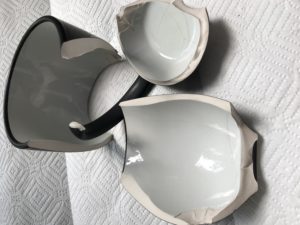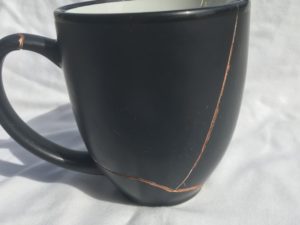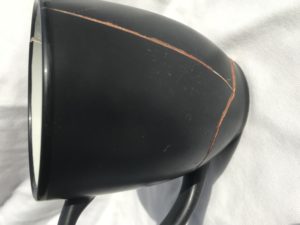Not too long ago, at my favorite new coffee shop, I was sitting across from a couple engaged in a rather animated conversation when one of them dropped their black ceramic coffee mug. Dunn Bros coffee mugs are sturdy vessels that feel weighty and present in your hand.
The mug hit the tile floor, not with a disintegrating shatter but a formidable crack. Breaking not into countless pieces, but precisely three. The couple laughed and stood to leave. Leaving the coffee shop and their mess behind for others to tend.
I have no idea what drew me to the fractured pieces. Their simplicity. The broken symmetry. The three heavy single pieces. But I found myself kneeling down to pick them up.
“Don’t cut yourself,” the aproned staff member warned me as he appeared with a broom and dustbin in hand.
“Thank you, but I’m ok. It’s only three pieces and they aren’t sharp,” I replied.
He extended the dustbin for me to deposit the pieces.
“May I keep them?”
He gave me a quizzical look and walked away muttering something about not leaving blood on his floor. I put the three pieces in my bag to take home to wash and examine further.
I found that with some careful manipulation I could reconstruct the mug in my hands. Delicately holding each piece in place. Using all ten fingers to hold three pieces. I discovered that there were in fact smaller shards missing here and there, but the remaining pieces in my hand definitely gave the illusion of what it once was…a heavy black ceramic coffee mug.
Now. How to join the pieces?
That took me to Google, the source of all human knowledge, and it’s there I discovered… Kintsugi, the ancient Japanese art of “golden joinery.”
Like most eastern art forms, Kintsugi began as a pragmatic means of repairing fine china and ceramics but evolved into a creative expression. And from an art form into something spiritual. The practice of Kintsugi is said to have originated in the 15th century when Japanese shōgun Ashikaga Yoshimasa sent a damaged ceramic tea bowl back to his country for repairs. It was returned, repaired with ugly metal staples, and may have prompted Japanese craftsmen to look for a more aesthetic means of repair. It soon became a practice of repairing broken pottery with lacquer dusted with powdered gold.
As a philosophy, kintsugi became a study of embracing the flawed and imperfect. Highlighting the cracks and seeing the repairs as simply an event in the life of an object rather than allowing its service to end at the time of its damage or breakage.
I wept. And I bit. Hard. Hook, line, and sinker. This resonated to my core. The application of kintsugi to my own life voyage was not only profound emotionally but spiritually. I would have to explore this further.
With kintsugi, not only is there no attempt to hide the damage, but the repair is literally illuminated. The variations and effects of life forces over time, to which all of creation is susceptible, is so clearly represented in the break, the knock, and the shattering of the mug…and me.
So I spread out a sheet on the floor and sat with my three pieces. The pieces of the mug. The pieces of me. And started to mend them both.
The true ancient art involves the use of lacquer, resin, and gold dust. None of which I have in my tool box at the house. So a trip to Hobby Lobby resulted in epoxy and a tiny jar of decorative gilded gold pearl dust. I was confident that Yoshimasa would forgive me for using more practical methods on my first attempt of a practice thats taken over 1,000 years to refine.
I found the time and patience it took to be very cathartic. The healing process of the trauma to the mug, and my own, were very revealing.
First gathering the pieces of what remained. Seeing if it all resembled what I thought it once was and could be again.
Then smoothing out the sharp edges. Cleaning the wound. Making sure what was left could be joined again. Or whether it even wanted to be repaired.
I took the first two largest pieces. Then the first application of epoxy. Only a few drops were needed then patiently waiting for it to set. Delicately removing my fingers to see if it held. It seemed to. But then the two pieces began to separate. I pressed them together again and waited longer this time. I held it in my hand for 5 minutes. Then placed it down to cure for even longer. It held this time. I could see the crack. But the pieces were together.
I noticed connecting the third piece was more difficult than I imagined it would be. The first two pieces took space that belonged to the third so it took some filing, sanding, and coaxing for it to fit. It seemed envious of the first two pieces but it too knew it belonged.
I let all three rejoined pieces cure for several days. Patience, it seems, is an important and often overlooked step in joinery and recovery. Then I sat down to mix the remaining epoxy with my jar of gold pixie dust. Carefully filling in the visible seams. With a toothpick and tiny paintbrush, applying one more layer of shimmering gold epoxy. Making the healed wound even stronger while highlighting it too. Ah, the paradox. Turning trauma into a transcendent treasure.
Trauma in our culture is fascinating. Both physical and psychological trauma are a type of damage to the mind or body that occur as a result of a severely distressing event. The floor distressed the coffee mug. This young mug. Something else, someone else, distressed me. This young child. And as the dutiful Dunn Bros appeared with the broom and dustbin to discard the traumatized coffee mug. Well…what did I see in his eyes as he looked at me?
It seems so much of our culture is about moving past pain. Finding ways to mask it. Finding ways to remove scars. The result is opioid addiction, alcoholism, abusive relationships, secondary addictions, and the false pretext that hidden pain is forgotten pain.
What I found in the golden joinery of my coffee mug was an embracing of a wound. Mine. Celebrating brokenness. Realization that a fracture is not the end, but simply a moment in history. Not hidden, but goldenly significant.
“The world breaks everyone and afterward many are strong at the broken places.” -Ernest Hemingway, A Farewell to Arms
It’s what I love about Holy scripture. The Bible narrative never omits weakness. Consider Joseph, Job, Moses, Gideon, David, and the many public plunders of St. Peter. All were victors with well known scars.
Just as in kintsugi, their brokenness wasn’t something to be hidden but rather a vital part of their redemptive story! The same story God wrote for all of His creation.
As Paul wrote, “God’s power is made perfect in weakness.” Paul displayed his traumatic fractures because he knew Christ would be glorified in all of them. (2 Corinthians 12:9-10 ESV)
So it seems that often in the process of repairing things that have been broken, something more unique, beautiful and resilient is created.
Quoting Dr. Martin Luther King, “As my sufferings mounted I soon realized that there were two ways in which I could respond to my situation — either to react with bitterness or seek to transform the suffering into a creative force. I decided to follow the latter course.”
I too will follow that course. That narrative. Displaying my golden joined wounds as manifestations of the redemptive healing that was gifted to me by His grace and His son.
Latest posts by drewdickens (see all)
- Eager To Do Good - March 13, 2024
- Enhancing Athletic Performance: The Power of Christian Meditation in Barcelona World League Soccer - March 13, 2024
- Stillness in the Spirit: Embracing Christian Meditation in Modern Life - March 12, 2024



